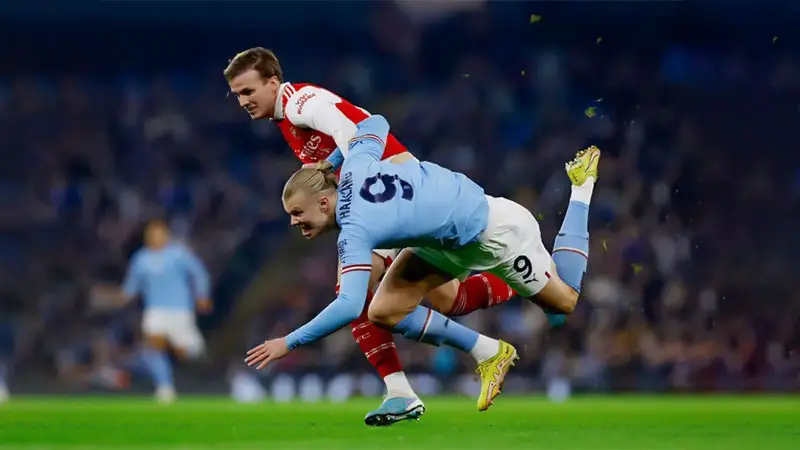The holding foul in soccer is a tactical move used by players to impede opponents, potentially influencing the game’s outcome with penalties or free kicks. It’s crucial for teams to understand this rule for a strategic advantage.
Players walk a fine line between fair play and foul, requiring skill to hold without being caught. Appreciating the nuances of the holding foul can deepen one’s understanding of the strategic elements in a soccer match.
Recognizing the signs of a holding foul can help players anticipate and counteract this tactic effectively during a match.
By mastering the art of subtle holding without drawing the referee’s attention, players can gain an advantage over their opponents while staying within the boundaries of fair play.
Decoding Soccer Holding Fouls
Soccer holding fouls are infringements that can significantly impact game outcomes. Players commit holding fouls by impeding an opponent’s progress, leading to penalties or free kicks. Understanding the nuances of this rule is crucial for gaining a strategic advantage on the field.
Definition and Rules
Holding fouls in soccer occur when a player uses their hands, arms, or body to hold an opponent, restricting their movement. This action is considered a violation of the rules and can result in a direct or indirect free kick for the opposing team.
Referees closely monitor such fouls to ensure fair play and maintain the integrity of the game.
How Holding Fouls Affect Gameplay
Holding fouls disrupt the flow of the game and can change the course of play. When a holding foul is committed, it often results in a stoppage of play, allowing the opposing team to regroup or capitalize on set-piece opportunities.
By understanding how holding fouls impact gameplay, players can strive to maintain a balance between tactical aggression and fair play on the field.
Types of Holding Fouls in Soccer
In soccer, holding fouls are a common occurrence that can significantly impact the flow and outcome of a game. Understanding the different types of holding fouls is crucial for players, coaches, and fans alike.
Here are two key categories of holding fouls:
Defensive Holding
Defensive holding is a tactic often used by defenders to impede the progress of opposing players. It involves grabbing, pulling, or obstructing an opponent without making a play for the ball.
This type of holding foul can lead to free kicks or penalties, giving the opposing team an advantage. Referees closely monitor defensive holding to maintain fair play and discourage overly physical tactics.
Midfield Holding
Midfield holding refers to holding fouls committed by players in the midfield area of the field. These fouls typically occur during battles for possession or when trying to disrupt the rhythm of the opposing team’s play.
Midfield holding can result in turnovers, free kicks, or yellow cards depending on the severity of the offense. Players engaging in midfield holding must toe the line between aggressive play and breaking the rules to avoid penalties that could harm their team’s performance.
By understanding the nuances of defensive and midfield holding fouls, players can better navigate the rules of the game and make strategic decisions to benefit their team. Referees play a crucial role in enforcing these rules to ensure fair and competitive gameplay in soccer.
Consequences of Holding Fouls
Soccer holding fouls can have immediate and lasting effects on both individual players and teams. Here is a breakdown of the consequences associated with these infractions:
Short-Term Impacts During a Match
In the heat of the game, a holding foul can result in a direct free kick or even a penalty kick for the opposing team. This immediate consequence can significantly alter the flow of the match, potentially leading to goals scored against the team committing the foul.
Moreover, players who accumulate multiple holding fouls may receive yellow or red cards, resulting in temporary or permanent player disadvantages, affecting team dynamics on the field.
Long-Term Penalties for Players and Teams
Beyond the match itself, holding fouls can have long-term repercussions for players and teams. Players who develop a reputation for frequently committing holding fouls might face disciplinary action from soccer governing bodies, such as suspensions or fines.
Additionally, teams known for engaging in holding tactics excessively may tarnish their reputation, impacting sponsorship deals, fan support, and overall team success.
Moreover, a history of holding fouls can lead to increased scrutiny from referees and opponents, making it harder for players and teams to compete at the highest levels effectively.
Examples of Famous Holding Fouls
Holding fouls have shaped the outcomes of many high-stakes soccer matches. Here are notable instances where holding fouls significantly influenced game dynamics and final results.
2018 FIFA World Cup Final: France vs. Croatia
During the 2018 FIFA World Cup final, a significant holding foul took place that had a notable impact on the match. In the 18th minute, French forward Antoine Griezmann was fouled by Croatian defender Mario Mandzukic inside the penalty area.
The referee awarded a penalty kick to France, which Griezmann successfully converted. This early goal set the tone for the rest of the game, contributing to France’s 4-2 victory and their second World Cup title.
2020 UEFA Champions League Final: Paris Saint-Germain vs. Bayern Munich
In the UEFA Champions League final in 2020, a key holding foul occurred during a tense moment between Paris Saint-Germain (PSG) and Bayern Munich.
During a set-piece situation, Bayern Munich’s defender Leon Goretzka was caught holding PSG’s striker Kylian Mbappe inside the box.
The referee awarded a penalty kick to PSG, although they failed to convert it. This incident highlighted the physicality and high stakes of the game, emphasizing the impact of holding fouls in crucial matches.
2010 FIFA World Cup Quarter-Finals: Brazil vs. Netherlands
A famous holding foul happened during the 2010 FIFA World Cup quarter-final match between Brazil and the Netherlands. Brazilian defender Felipe Melo held Dutch forward Arjen Robben as he tried to break through the defense.
The foul resulted in a free kick for the Netherlands, which eventually led to a goal, turning the momentum in favor of the Dutch team. The Netherlands went on to win the match 2-1, knocking Brazil out of the tournament.
2014 FIFA World Cup Group Stage: Greece vs. Ivory Coast
In the 2014 FIFA World Cup group stage match between Greece and Ivory Coast, a critical holding foul took place in the dying moments of the game. Greek forward Giorgos Samaras was held by Ivorian defender Giovanni Sio inside the penalty area, leading to a penalty kick.
Samaras converted the penalty, securing a 2-1 victory for Greece and their spot in the knockout stage of the tournament.
How Officials Identify and Manage Holding Fouls
Referees play a crucial role in identifying and managing holding fouls, utilizing keen observation, communication, and technology like VAR to ensure fair play and game integrity.
Role of Referees and Technology
Referees play a crucial role in identifying and managing holding fouls on the soccer field. Their primary responsibility is to ensure fair play and implement the rules of the game effectively.
With the advancement of technology, referees now have access to tools like VAR (Video Assistant Referee) to review critical decisions, including potential holding fouls that may have been missed during live play.
This technological support enhances the accuracy of officiating and helps maintain the integrity of the game.
Communication and Decision-Making
Effective communication among officials is essential in managing holding fouls. Referees must collaborate with assistant referees to cover different areas of the field and identify foul play promptly.
Clear and concise communication helps streamline decision-making processes, ensuring that holding fouls are addressed promptly and appropriately. By working together seamlessly, officials can uphold the rules of the game and promote fair competition on the field.
Frequently Asked Questions
What are holding fouls in soccer?
Holding fouls in soccer involve grabbing or impeding an opposing player’s movement, typically by holding onto their upper torso or shorts. This action is considered a foul and can result in penalties or disciplinary actions.
Why are holding fouls penalized?
Holding fouls are penalized in soccer because they disrupt fair play and pose a risk of injury to players. By preventing opponents from moving freely, holding fouls give unfair advantages and go against the rules of the game.
Can holding give a strategic advantage?
Holding in soccer can provide a strategic advantage by impeding the progress of opponents or disrupting their gameplay. However, it is considered unsportsmanlike conduct and is penalized to maintain fair competition on the field.
How do referees handle holding fouls?
Referees play a crucial role in identifying and penalizing holding fouls during soccer matches. They monitor player actions closely, use tools like VAR for accuracy, and communicate effectively with officials to enforce rules and ensure fair play.
Conclusion
Holding fouls in soccer impact game dynamics significantly, affecting results and providing strategic benefits. Referees play a crucial role in managing these infractions to ensure fair play, with technology like VAR enhancing accuracy.
Understanding the balance between aggression and fairness is essential for players to avoid penalties and navigate the game effectively.
Cooperation among officials is vital in promptly addressing fouls and promoting equitable competition, while consistent enforcement of rules contributes to a level playing field.
It is important for players to be mindful of their physicality on the field to avoid getting penalized for holding fouls, which can disrupt the flow of the game and give the opposing team an advantage.
Consistent enforcement of rules by referees is key in maintaining fair competition and upholding the integrity of the sport.








Brice Petersen